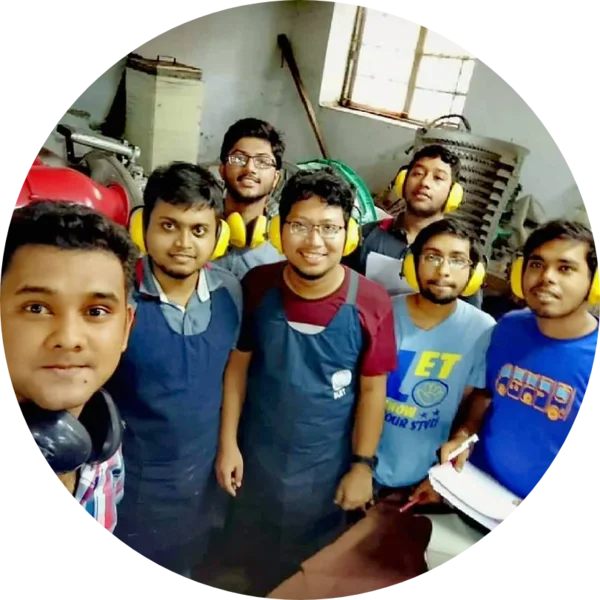I am a passionate mechanical engineer and a young researcher. Currently, I am working on a collaborative project funded by Engineering and Physical Sciences Research Council (EPSRC) at MμFEL. I am also working as a Lecturer at the Department of Mechanical Engineering in Sonargaon University (SU).I have completed my undergraduate education in Mechanical Engineering, from Bangladesh University of Engineering and Technology (BUET) in April, 2019.



B.Sc. in Mechanical EngineeringPublication(s)Taken Courses
Extracurricular Activities
| ||
2012 - 2014 Higher Secondary School CertificateExtracurricular Activities
| ||
2010 - 2012 Secondary School CertificateExtracurricular Activities
|
Department of Mechanical Engineering, BUET
January 2018 - Present
The research group of “Macro-to-Micro scale Fluids Engineering Lab (MμFEL)” is developed to study in modern bio fluid and gas dynamics related problems. The research group focuses on fundamental and applied phenomena in fluid mechanics using experimental, computational, and analytical approaches both in macro and micro scales.
November 2020 - Present
January 2018 - October 2020
147/I, Green Road, Dhaka
June 2019 - Present
Sonargaon University (SU) is one of the Bangladesh’s preeminent private universities, approved by University Grants Commission (UGC) of Bangladesh and Bangladesh Government (GoB).
Dhamrai Plant, Dhaka
October 2018 - October 2018
The ACME Laboratories Ltd. is a leading company for manufacturing world-class and top-quality pharmaceutical products in Bangladesh.
[Current Project]
Modelling the exposure risk tradeoff between public transit and private paratransit for transport decision making in the era of Covid19The COVID19 pandemic has massively disrupted the transport sector and economic activities. In the project countries, motorcycle-based paratransits are banned from operating in order to maintain safe distances. In addition to disrupting travel and affecting the primarily poor users (prices in other modes have gone up), this has also resulted in massive unemployment and poverty among the drivers. However, there are also serious concerns about the safety of passengers in crowded buses or micro-transit vehicles, where maintaining appropriate distances are nearly impossible, and paratransits can be a viable alternative.
In a microfluidic channel, mixing becomes troublesome as it is obviously constrained by mass diffusion at low Reynolds number. This work computationally analyzes the use of pulsating streams for possible enhancement of fluid mixing in a microchannel at Reynolds number of 0.2. A simple two-dimensional T-shaped microchannel is considered for this study.
A dominant mode of transmission for the respiratory disease COVID-19 is via airborne virus-carrying aerosols. As national lockdowns are lifted and people begin to travel once again, an assessment of the risk associated with different forms of public transportation is required. This paper assesses the risk of transmission in the context of a ride-sharing motorbike taxi—a popular choice of paratransit in South and South-East Asia and Sub-Saharan Africa. Fluid dynamics plays a significant role in understanding the fate of droplets ejected from a susceptible individual during a respiratory event, such as coughing. Numerical simulations are employed here using an Eulerian–Lagrangian approach for particles and the Reynolds-averaged Navier–Stokes method for the background air flow. The driver is assumed to be exhaling virus laden droplets, which are transported toward the passenger by the background flow. A single cough is simulated for particle sizes 1, 10, 50 𝜇m, with motorbike speeds 1, 5, 15 m/s. It has been shown that small and large particles pose different types of risk. Depending on the motorbike speed, large particles may deposit onto the passenger, while smaller particles travel between the riders and may be inhaled by the passenger. To reduce risk of transmission to the passenger, a shield is placed between the riders. The shield not only acts as a barrier to block particles, but also alters the flow field around the riders, pushing particles away from the passenger. The findings of this paper therefore support the addition of a shield potentially making the journey safer.
In a microfluidic channel, mixing becomes troublesome as it is obviously constrained by mass diffusion at low Reynolds number. This work computationally analyzes the use of pulsating streams for possible enhancement of fluid mixing in a microchannel at Reynolds number of 0.2. A simple two-dimensional T-shaped microchannel is considered for this study. Two pulsatile streams are kept out of phase by 90° while the pulsation frequency is kept constant at 7.5 Hz. However, the ratio of pulse amplitude to base velocity has been varied in the range of 5.0–12.5. Moreover, the ratio of pulse amplitudes of two streams has been changed from 1.0 to 2.0. It is observed that an increment of pulse amplitude to base velocity ratio results an increase in the degree of mixing inside the microchannel. In addition, fluctuation characteristics in mixing degree decrease with an increase in pulse amplitude. In case of varied pulse amplitudes of two streams, results showed that the quality of mixing is enhanced by increasing the ratio until 1.7. Finally, the required minimum length of a microchannel for a specific degree of mixing is identified from the results of the present work.